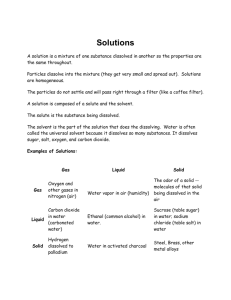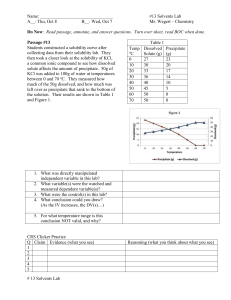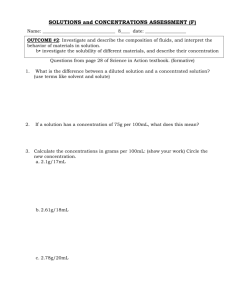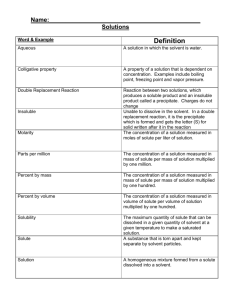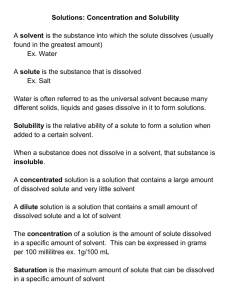Solutions and Osmosis INFORMATION
advertisement
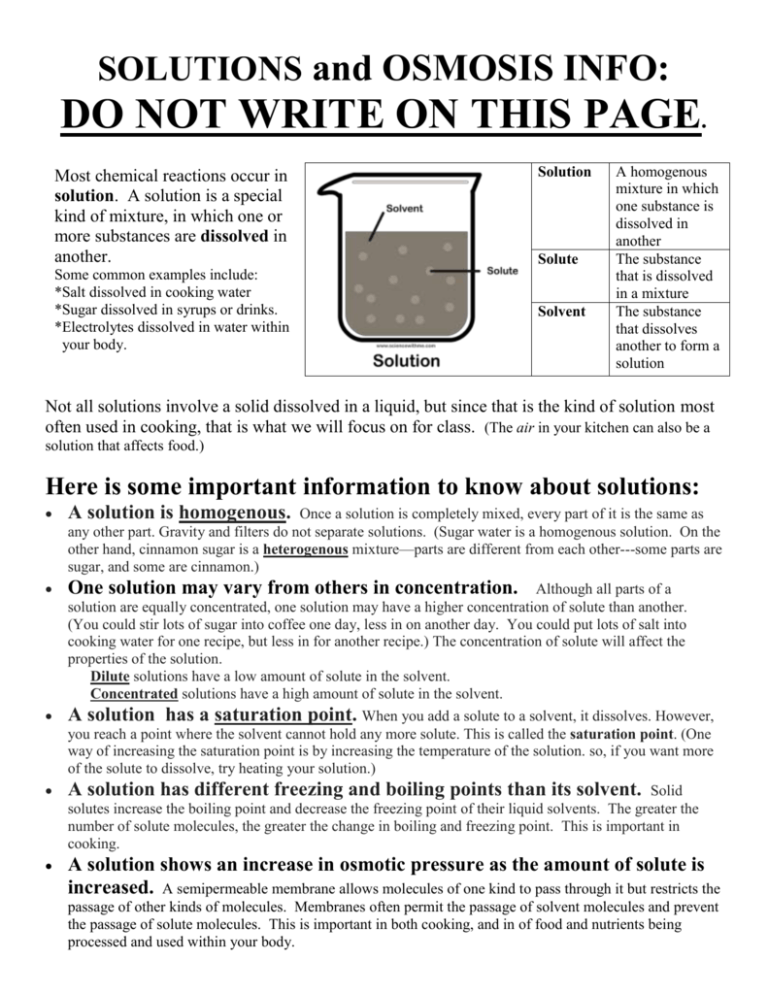
SOLUTIONS and OSMOSIS INFO: DO NOT WRITE ON THIS PAGE. Most chemical reactions occur in solution. A solution is a special kind of mixture, in which one or more substances are dissolved in another. Some common examples include: *Salt dissolved in cooking water *Sugar dissolved in syrups or drinks. *Electrolytes dissolved in water within your body. Solution Solute Solvent A homogenous mixture in which one substance is dissolved in another The substance that is dissolved in a mixture The substance that dissolves another to form a solution Not all solutions involve a solid dissolved in a liquid, but since that is the kind of solution most often used in cooking, that is what we will focus on for class. (The air in your kitchen can also be a solution that affects food.) Here is some important information to know about solutions: A solution is homogenous. Once a solution is completely mixed, every part of it is the same as any other part. Gravity and filters do not separate solutions. (Sugar water is a homogenous solution. On the other hand, cinnamon sugar is a heterogenous mixture—parts are different from each other---some parts are sugar, and some are cinnamon.) One solution may vary from others in concentration. Although all parts of a solution are equally concentrated, one solution may have a higher concentration of solute than another. (You could stir lots of sugar into coffee one day, less in on another day. You could put lots of salt into cooking water for one recipe, but less in for another recipe.) The concentration of solute will affect the properties of the solution. Dilute solutions have a low amount of solute in the solvent. Concentrated solutions have a high amount of solute in the solvent. A solution has a saturation point. When you add a solute to a solvent, it dissolves. However, you reach a point where the solvent cannot hold any more solute. This is called the saturation point. (One way of increasing the saturation point is by increasing the temperature of the solution. so, if you want more of the solute to dissolve, try heating your solution.) A solution has different freezing and boiling points than its solvent. Solid solutes increase the boiling point and decrease the freezing point of their liquid solvents. The greater the number of solute molecules, the greater the change in boiling and freezing point. This is important in cooking. A solution shows an increase in osmotic pressure as the amount of solute is increased. A semipermeable membrane allows molecules of one kind to pass through it but restricts the passage of other kinds of molecules. Membranes often permit the passage of solvent molecules and prevent the passage of solute molecules. This is important in both cooking, and in of food and nutrients being processed and used within your body. OSMOSIS is the movement of fluid across a semipermeable cell membrane so that there is an equal concentration of solute on both sides of the membrane. In osmosis, the solvent can cross the membrane barrier, but the solute is too large to cross. Solvent continues to cross the membrane until the concentrations of the solutions equalize. Here are some ways osmosis is related to food: Plants absorb water from the ground, but also lose it through their leaves. Foods can become wilted or dried out if water is allowed to evaporate from them. Cells absorb fluids through their cell walls Sugar or salt will pull juices out of a food, to its surface. Osmosis/diffusion video;; http://www.teachertube.com/video/osmosis-amp-diffusion-138155 Water and other liquids filter through the large intestine and are reabsorbed during digestion. Many foods quickly become soggy exposed to liquids. Some even lose their crunch if exposed to the moisture in the air for very long.

